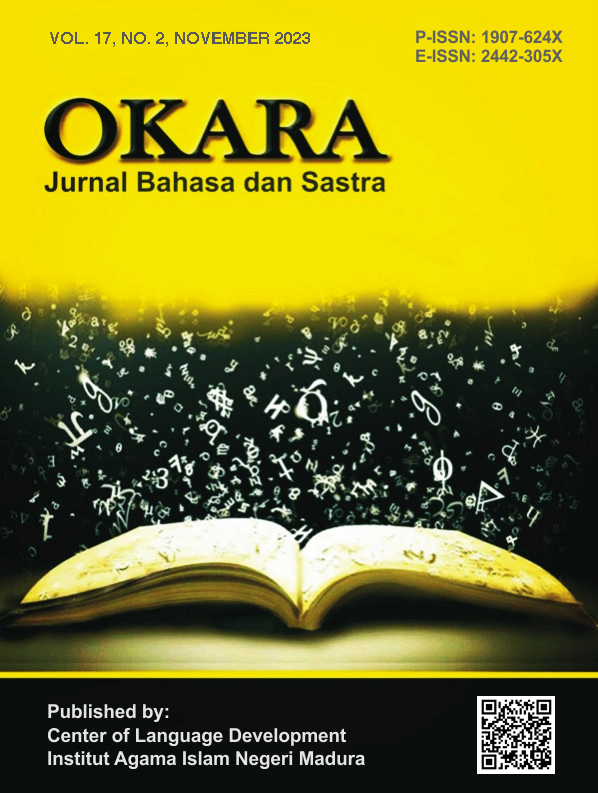The Image of Java and Its People in Emilie’s Eyes Under the Perspective of New Historicism
 Abstract views: 373
,
Abstract views: 373
,
 PDF downloads: 396
PDF downloads: 396
Abstract
Emilie Java 1904 by Catherine Van Moppès is a French novel that portrays Indonesia's portrait in Java in 1904, a century of Dutch colonialism in Indonesia. This novel describes Indonesian colonialism through the third lens, a narration from a French person's point of view. This research aims to identify the historiography of Java in 1904, where the Dutch carried out deep colonialism using a new historicism perspective. The qualitative descriptive method was used. The data involved words, phrases, and sentences containing Javanese historiography in the novel. This study found that 1) the Javanese people are friendly, embrace Islam, and have solid ancient beliefs. The nature of Javanese men who still despise women is also reviewed; 2) From the European perspective, Java's conditions are described as exotic and beautiful but chaotic and dangerous; 3) Colonialism is also seen from a neutral side by writing that shows the negative side of priyayi and the arbitrary attitude of the Dutch toward the natives. This novel implies that the Javanese were civilized before the Dutch came, which contradicts the primary purpose of Westerners coming to the East. Otherwise, she also showed the negative and positive side of Java and its people toward the Dutch.
Downloads
References
Ali, R. M. (2005). Pengantar Ilmu Sejarah Indonesia. Yogyakarta: LkiS Pelangi Aksara.
Anggarista, R., Nasrulloh, L., & Munasip. (2021). Kajian New Historisme dalam Novel Hati Sinden Karya Dwi Rahyuningsih. Jurnal Bastrindo, 2(2), 138–150. https://doi.org/10.29303/jb.v2i2.253
Artika, I. W. (2015). Pengajaran Sastra dengan Teori New Historicism. Prasi: Jurnal Bahasa, Seni, dan Pengajarannya, 10(20), 50–55. https://doi.org/10.23887/prasi.v10i20.8917
Barry, P. (2020). Beginning Theory: An Introduction to Literary and Cultural Theory (4th Edition). Manchester: Manchester University Press.
Brannigan, J. (1998). New Historicism and Cultural Materialism. New York: Palgrave Macmillan.
Farhana Rm, F., & Aflahah. (2019). Kolonialisme dan Nasionalisme dalam Novel Bumi Manusia Karya Pramoedya Ananta Toer. GHANCARAN: Jurnal Pendidikan Bahasa dan Sastra Indonesia, 1(1), 10–25. https://doi.org/10.19105/ghancaran.v1i1.2946
Huda, L. N. (2022). Portraits of Women in Exile and Colonization in the Novel De Liefde. Proceedings of the Sixth International Conference on Language, Literature, Culture, and Education (ICOLLITE 2022), 290–294. Atlantis Press. https://doi.org/10.2991/978-2-494069-91-6_45
Kaes, A. (1992). New Historicism: Writing Literary History in the Postmodern Era. Monatshefte, 84(2), 148–158.
Lyu, X. (2021). An Introduction to New Historicism. The Proceedings of the 6th International Conference on Social Sciences and Economic Development (ICSSED 2021), 1075–1078. Atlantis Press. https://doi.org/10.2991/assehr.k.210407.203
Moppès, C. V. (2002). Emilie Java 1904. Paris: Albin Michel.
Peekema, W. (1943). Colonization of Javanese in the Outer Provinces of the Netherlands East-Indies. The Geographical Journal, cI(4), 145–151.
Purwanto, B. (2012). Historisme Baru dan Kesadaran Dekonstruktif: Kajian Kritis terhadap Historiografi Indonesiasentris. Humaniora, 13(1), 29–44. https://doi.org/10.22146/jh.709
Ratna, N. K. (2010). Metodologi Penelitian: Kajian Budaya dan Ilmu. Yogyakarta: Pustaka Pelajar.
Ricklefs, M. C. (2017). Sejarah Indonesia Modern. Yogyakarta: Gadjah Mada University Press.
Safitri, D., Waluyo, H. J., & Saddhono, K. (2019). Posmodernisme dan Poskolonialisme Kumpulan Puisi Kerikil Tajam dan Yang Terampas dan Yang Putus Karya Chairil Anwar Serta Relevansinya dengan Pembelajaran Sastra di SMA. Prosiding Seminar Nasional “Inovasi Pembelajaran Bahasa Indonesia di Era Revolusi Industri 4.0,” 244–247. Retrieved from https://jurnal.fkip.uns.ac.id/index.php/pbi/article/view/12776
Sahliyah, C. (2017). Kajian New Historicism Novel Kubah Karya Ahmad Tohari. Jurnal Pendidikan Bahasa dan Sastra UPI, 17(1), 111–119.
Salverda, R. (2005). The Case of the Missing Empire, or the Continuing Relevance of Multatuli’s Novel Max Havelaar (1860). European Review, 13(1), 127–138. https://doi.org/10.1017/S1062798705000128
Sugiarti. (2013). Analisis Kritis New Historicism Terhadap Novel Indonesia Modern dalam Kerangka Sejarah Sastra. LITERA, 8(2), 165–178. https://doi.org/10.21831/ltr.v8i2.1210
Swingewood, A., & Laurenson, D. (1972). Sociology of Literature. London: Paladin.
Teeuw, A. (1983). Membaca dan Menilai Sastra, Kumpulan Karangan. Jakarta: Gramedia.
Wahyudi, T. (2013). Sosiologi Sastra Alan Swingewood Sebuah Teori. Poetika: Jurnal Ilmu Sastra, 1(1), 55–61. https://doi.org/10.22146/poetika.v1i1.10384
Wiryopranoto, S., Herlina, N., Marihandono, D., & Tangkilisan, Y. B. (2017). KI Hajar Dewantara: Pemikiran dan Perjuangannya (D. Marihandono, Ed.). Jakarta: Museum Kebangkitan Nasional.
The journal operates an Open Access policy under a Creative Commons Attribution-NonCommercial 4.0 International License. Authors who publish with this journal agree to the following terms:
- Authors retain copyright and grant the journal right of first publication with the work simultaneously licensed under a Creative Commons Attribution License that allows others to share the work with an acknowledgement of the work's authorship and initial publication in this journal.
- Authors are able to enter into separate, additional contractual arrangements for the non-exclusive distribution of the journal's published version of the work (e.g., post it to an institutional repository or publish it in a book), with an acknowledgement of its initial publication in this journal.
- Authors are permitted and encouraged to post their work online (e.g., in institutional repositories or on their website) prior to and during the submission process, as it can lead to productive exchanges, as well as earlier and greater citation of published work.





_(1).png)
.png)
.png)
1.png)
.png)
.png)

.png)
_-_Copy_-_Copy.png)





